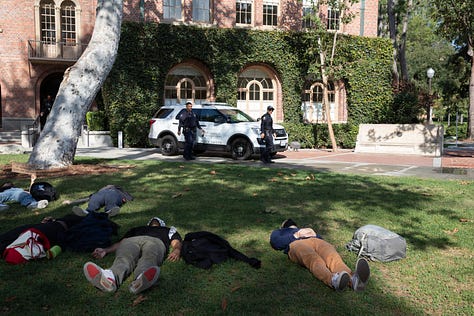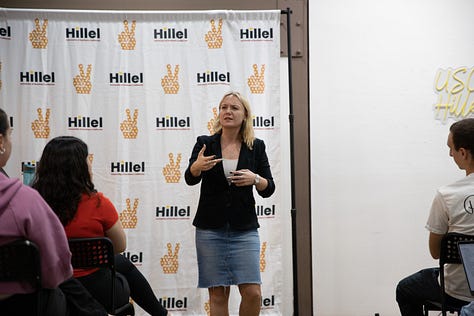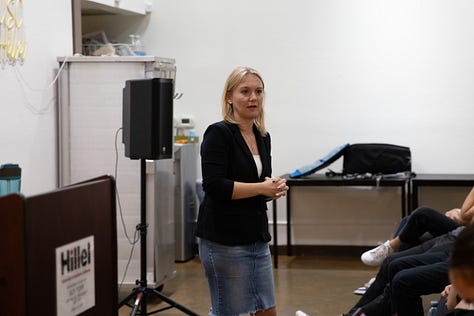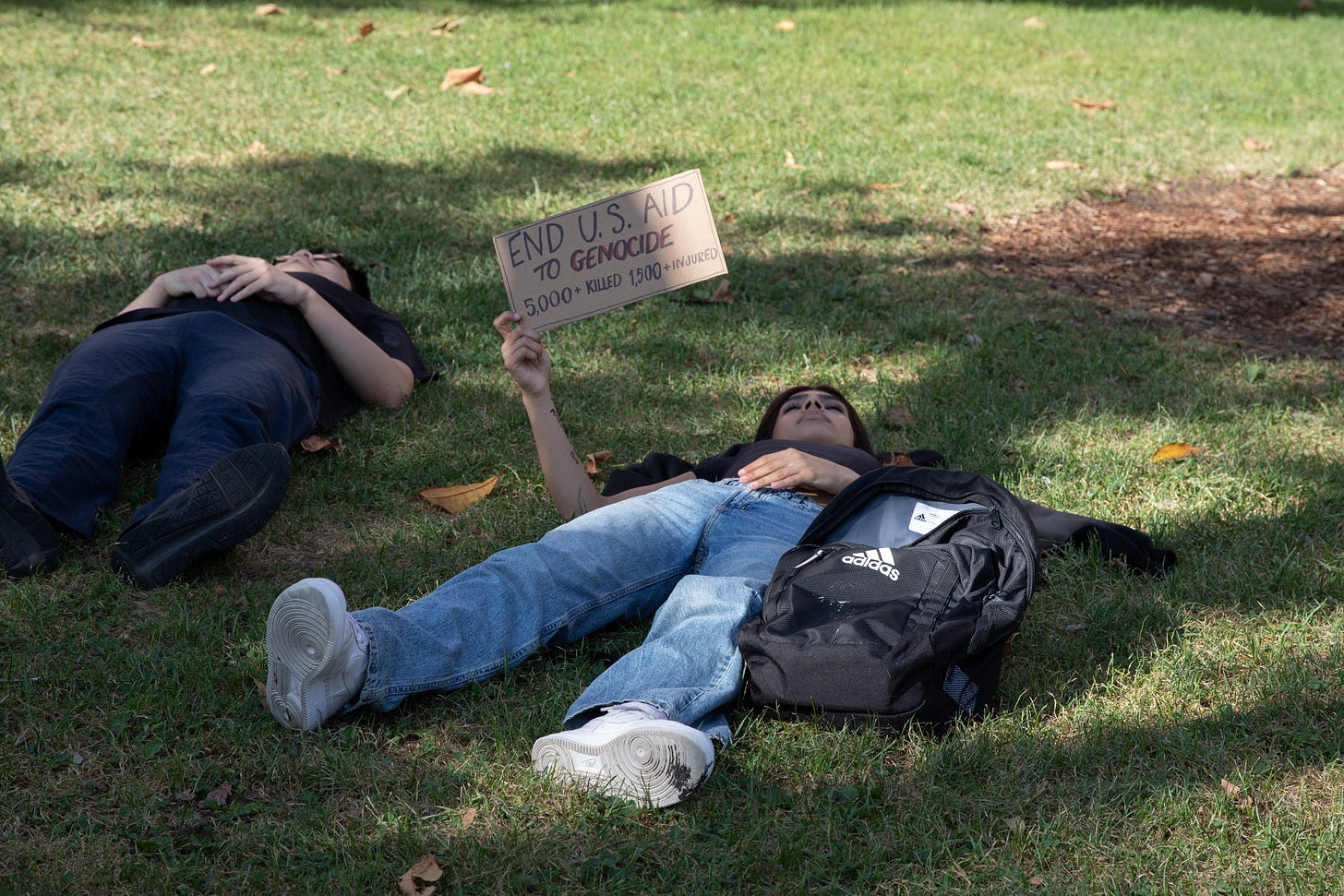My point of view on photography has changed since the start of this semester. For as long as I can remember, I used photography as a creative outlet to share how I, Jordan Renville, saw the world. The entire process had always been very independent. Rarely did I find myself looking at other's work, let alone the work of my peers at USC, because I was so focused on honing the artistry in my own creations. I held this inward-facing posture towards my work and photography until three weeks ago, when my identity as a photographer drastically changed. I've been working as a staff photographer for the Daily Trojan since the start of this semester, capturing various events in what has been a remarkably politically charged, emotional, and busy few months for not only the USC community but for the world. Three weeks ago, the Photo Editor, in other words, the person in charge of all photography for the Daily Trojan, stepped down, and the editorial board offered me the opportunity to be the new Photo Editor of the paper.
Despite having no experience in leading a group of photographers, I said yes, and considering the unexpected nature of taking this leadership position, I had to, and still continue to, learn things quickly. Apart from the day-to-day management of assigning photographers to different events and brainstorming creative ideas with writers, the biggest thing I've had to learn is how to review other photographer's work. I've realized that it is important, not only for the paper but for myself, to leave a lasting impact on the images we see on a daily basis at USC. One of the ways that I have been doing that is by giving detailed feedback to all of my photographers on the work they produce on a weekly basis. At the end of each week, I sit down and review countless photographs, not only to provide praise and criticism but to learn and genuinely improve the quality of our work.
This past week, Monday the 23rd to Sunday, October 29th, was one of our busiest weeks in terms of photography we have had this year. Sports, guest panels, impromptu protests, and continued unrest between student groups were all highlighted, to name a few. As I went through the various photo albums collected for the week, I couldn't help but pay special attention to the work of Emma Silverstein and her coverage of the Palestinian Die-in protest, which happened on that Thursday. These photos were meaningful not only because of the visual elements used throughout but also because of the social and cultural significance that they carry for our community. It is also important to think about Emma as a photographer and how her experiences shaped the artistic lens from which she took these photos.

In order to understand the various visual components included in these images, I feel it's important first to have knowledge of the contextual significance of this event and these photos. October 2023 was an Incredibly difficult political time in our world, primarily because of the conflict in Gaza between Israel and Hamas. While this territorial dispute has been going on for decades, This region made global headlines on October 7th when a barrage of missiles rained down on Jerusalem, Israel. With not enough time to evacuate the area, many people were killed, and as the dust settled, it became clear that this was an attack by Hamas, a militant group fighting against what they say is the collective punishment of Palestinians within the Gaza Strip for decades. Deeply threatened by this attack, the Israeli army launched a full-scale retaliation against Hamas that has ended up in not only the killings of Hamas members but thousands of Palestinian civilians. No matter what side of the aisle you are on when it comes to this issue, it has become clear that people around the world hold very strong viewpoints on this matter. Additionally, the sheer death and destruction caused by this conflict is causing a humanitarian issue, considering a majority of the deaths are civilian.
The conflict in Gaza also has relevance In the United States as many people with ties to Palestinian and Israeli heritage or beliefs have shown their support for either side. College campuses around the country seem to be the leading places of tension surrounding the conflict, with hundreds of protests for both sides happening at almost every major institution. The Die-in protest covered by Emma was actually the third of four Palestinian protests that have happened on USC's campus since October 7th, along with various public displays in support of both Israeli and Palestinian student bodies on campus. In fact, the same day that Emma covered this protest, she also covered a talk put on by the Israel student body that talked directly about the conflict from an Israeli perspective.
This form of protest considered a Die-in, was particularly unique in the fact that all the participants were lying on the ground to simulate being dead. Considering that far more Palestinians have been killed in this conflict than Israelis, the organizers of this protest wanted to highlight this disparity in the conflict by giving the USC community a visual of the death and carnage that is occurring in Gaza.



Considering the contextual significance of this protest, It becomes clear to see how the visual elements in these photos combine to tell a story. While the entire collection of 16 photos all show unique perspectives and are visually interesting, I specifically want to highlight these three and their attention to composition. As a photographer, the number one thing behind having the correct camera settings is to compose the elements within the frame together in order to tell a story or hold the viewer's attention. As a photojournalist working in a live environment that you cannot alter, meaningful composition oftentimes requires great timing use of angles and intuition for lighting, which the casual viewer far too often undervalues.
Take, for example, the first image with the DPS officers in the background and the protesters lying in the foreground. This is a classic example of a conflict shot that doesn't actually depict any physical conflict. By placing the police officers in the background and the protesters in the foreground, Emma was able to create visual conflict because, spatially, the two groups of people are at odds with each other. Going more in-depth, this spatial difference also puts the officers above the protesters in the frame, establishing a power dynamic that is especially relevant considering the constant policing and silencing felt by many Palestinian students on campus. One could even say that the harsh shadows provided by the tree overhead mimic blood flowing from the bodies on the ground and further sell the concept that these people were simulating the brutal death of Palestinians in Gaza.
The second visual element that I feel is important is the use of signage. Throughout many of these photos, Emma chooses to highlight the signs made by Palestinian protesters that call for action by USC and for peace in Gaza. I first want to acknowledge the interpretation of text in photography that it spoon-feeds information to the viewer instead of guiding the viewer to a conclusion on the photo naturally. While I do believe that some photos suffer from text, Others are visually aided by text when The text has direct ties to what is happening in the picture. For example, look at the above image of a young woman holding up a sign that states, "STOP U.S. AID TO GENOCIDE 5,000+ KILLED 1,500 INJURED". Under normal circumstances, this text might be considered spoon-feeding. However, here, I believe that It adds to the image because the woman holding up the sign also appears to be dead. This can lead to a reading of the photo in which Palestinians are not only fighting for the end of this killing and death but for the people who have already died. This, coupled with the harsh shadows from the trees mentioned earlier, really sells a photojournalistic story.
With that said, It is also important to note some of the visual oversights contained in this album. One of the biggest issues that I have with this album when talking in regards to the print and online publication, which you can access here, is its slightly flat editing style. As someone who is constantly looking at photographs and producing them myself, I know that the human eye naturally gravitates toward color and, even more importantly, contrast within an image. When looking at these images compared to other photographs, either in print or on the Daily Trojan website, it's clear to see that there's less contrast in these, which can make it easy for the viewer to overlook the importance of these photographs. When just glancing over the various articles that we produce, photos with the most color contrast, within reason, are typically the most eye-catching to a casual viewer, and unfortunately, it may take a more experienced eye to appreciate the beauty of the photos that Emma captured. Moreover, various Points throughout the image suffered from slight detail loss in the highlights, which points to an error in editing as well as composition since typically, as we're photographers, you look to have the subject situated in the brightest part of the image without overexposing in order to draw attention there.
These technical “mistakes” point me to my third and final point on Emma's work, which has to do with her as not merely a soulless vessel taking these photos but a real person who is also tangentially involved in everything that is going on. Apart from any visual elements of photography, arguably the hardest part of being a photojournalist is documenting these emotionally charged events while remaining unbiased and being okay with the mistakes that are present in your work. Just because I might consider the lack of contrast in these images as a weak point does not take any artistry away from the photo and, in fact, highlights the differences in artistic styles between all photographers. Given the conditions that she had, Emma Confidently took photos, and that confidence in capturing something that is truly important for the USC community shines throughout the entire collection. The even more impressive aspect of this is that she was able to create equally as powerful images just hours later in a room full of people who are considered the enemy of those Palestinian protesters.



To me, this human aspect is really why photography is such an important art form. Although I was able to put words to the visual elements used in all these photos and explain why one might get certain feelings from them, these technical aspects are often lost by the casual viewer, and all they're left with are the raw human emotions that these pictures evoke. By looking at photography and the human connection to the images that we see, we find patterns that exist not only within art but in our own everyday lives as well. Are the feelings that we feel simply the result of life composing a scene in front of us the same way photojournalists do consciously every day? Honestly, I think so. Photojournalists have the unique duty to frame life for us when we can't be there to do it ourselves, which, when you think about it, is an incredible burden to bear. Doing so without directly inputting your own implicit bias is almost impossible; however, Emma was able to do that here.
As I move forward in my job as photo editor of the Daily Trojan, It is not lost on me the significance that all of our photos have on the USC community. Without even knowing it, one of our photos could shape the way that people see an issue, and I hope to continue analyzing and reviewing these photos as not just coverage of an event but pieces of a collective history. Every day, I strive to Inspire the same passion that I have for photojournalism into the eyes of every photographer on my team and turn a much too often overlooked form of art into something special.


